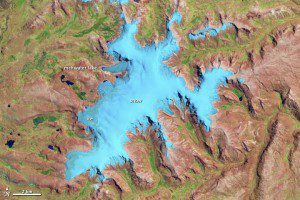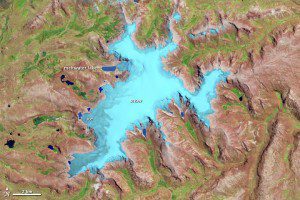
In this 1988 Landsat 5 satellite image, brick-colored land around the glacier is largely barren. Green patches indicate vegetation, mostly wetlands. Snow and ice appear in shades of light blue or cyan. The difference between snow and ice is subtle, but snow is slightly lighter. Liquid water appears blue, but not all ponds and lakes are the same shade of blue. Meltwater lakes along the margins of the ice are typically lighter due to fine particles produced by the grinding movement of the ice over bedrock.
Glaciers and ice caps are excellent recorders of climate change, but satellites show that when they recede quickly, they can become potent symbols of warming trends throughout the world.
Peru's Quelccaya Ice Cap is rare for several reasons. Situated at 13.5 degrees south latitude, it lies between the Tropic of Capricorn and the Equator, and it is the world's largest tropical ice cap. This collection of glaciers grows on a high-altitude plateau in the Andes Mountains, between the Amazon jungle to the east and tropical, eastern Pacific waters to the west.

In this 2010 Landsat 5 satellite image, the biggest meltwater lake lies at the end of the Qori Kalis glacier in the northwestern half of the ice cap. Between 1988 and 2010, the lake grew as Qori Kalis shrank. Over the same period, eight additional meltwater lakes grew around the margins of the ice cap.
Because of its location, the ice cap captures chemical signatures of the cycles of El Niño and La Niña. Those signatures from the atmosphere are locked in ice cores that Lonnie Thompson and colleagues from The Ohio State University have drilled from Quelccaya, and they provide nearly year-by-year records of temperatures and atmospheric composition dating back 1,800 years.
Based on field and laboratory work by Thompson's team”as well as three decades of satellite imagery”scientists also know that Quelccaya has been shrinking rapidly. The Thematic Mapper on the Landsat 5 satellite captured the accompanying images of Quelccaya in September 1988 and September 2010. Both images use a combination of visible, near-infrared, and shortwave infrared light.
Images courtesy of NASA.

